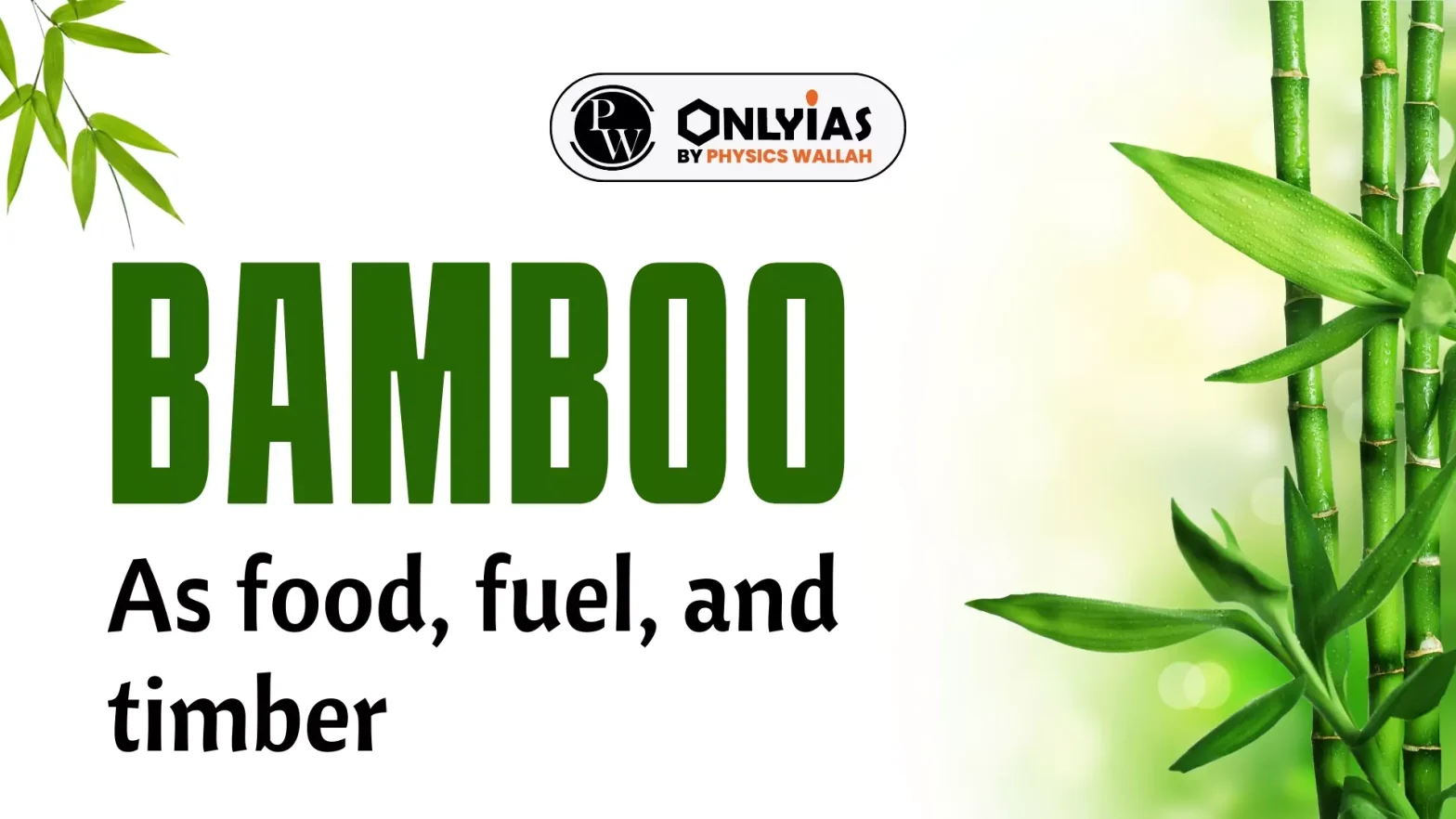Bamboo, often referred to as the “poor man’s timber,” has emerged as a lucrative crop for farmers, earning it the epithet “green gold.” Its cultivation, when carried out with modern agronomic practices, is proving to be more rewarding than many other crops, including highly lucrative ones like sugarcane and cotton.
Government Initiatives to Promote Bamboo Farming
- Recognizing bamboo’s potential to increase farmers’ income, the government has revamped the National Bamboo Mission and the Mission for Integrated Development of Horticulture. These schemes are being implemented to promote bamboo farming across different parts of the country.
- The programs include measures to encourage the use of bamboo as an alternative to wood in various sectors and to build a value chain for producing, domestically marketing, and exporting bamboo and its products.
- For example, in Madhya Pradesh, bamboo-made furniture for government purposes is increasingly being used.
- In Assam, everyday products like toothpaste and combs are made from bamboo. In Tripura, small-scale enterprises produce bamboo sticks, which are then sold to larger manufacturing companies.
- The government is aiding these small firms by providing subsidies, thereby creating a value chain.
- The government is also recognizing the potential of bamboo for farmers and helping them market their products domestically.
- For instance, local artisans can be seen selling bamboo products near metro stations.
Enroll now for UPSC Online Classes
India’s Bamboo Boom: Market Potential, Policy Changes, and Expansion Initiatives
Market Potential
- NITI Aayog has projected the global bamboo market to be worth around $98.3 billion by 2025.
- India, being the world’s second-largest bamboo producer after China, is striving for a significant share of this booming market.
- The country boasts as many as 136 well-documented native species of bamboo and produces about 3.23 million tonnes of this highly valuable and versatile plant annually.
Policy Changes
- The cultivation of bamboo as an agricultural crop, rather than just wild produce, was facilitated by the well-advised amendment to the Indian Forest Act in 2017, which reclassified bamboo as “grass” instead of a “tree.”
- This change freed bamboo from various restrictions related to the harvesting, transportation, and sale of trees and other kinds of forest produce.
- This move is supported by the botanical classification of plants, which places bamboo in the Poaceae (Gramineae) family of grasses, alongside important food crops like wheat, rice, oats, rye, maize, barley, sorghum, and millets.
- Bamboo can now be grown like any other crop and marketed without the need for a licence or permission from the forest department or any other government agency.
Expansion Initiatives
- Bamboo farming is rapidly spreading in areas such as Madhya Pradesh, Chhattisgarh, the Andaman and Nicobar Islands, and the Western Ghats, in addition to its natural habitats in the Northeastern region and West Bengal.
- The land under bamboo cultivation is estimated at over 15.70 million hectares, with the Northeastern zone accounting for about 50 percent of the country’s overall bamboo resources.
- Recent media reports indicate that the number of bamboo farmers has doubled in Gujarat over the past couple of years.
- The Maharashtra government has also announced plans to expand the area under bamboo farming by 10,000 hectares, offering an incentive of ₹7 lakh per hectare. This initiative is part of the state’s strategy to create carbon sinks (carbon dioxide sequestration zones) to contain environmental pollution.
Uses of Bamboo Plant
- Bamboo plants are known for their efficiency in converting carbon dioxide into oxygen. Studies have shown that bamboo produces about 35 percent more oxygen than most other vegetation.
- Bamboo is also among the fastest-growing plants in the world. It can grow between 30 cm and 90 cm (1 to 3 feet) in a single day, making it one of the most efficient producers of biomass. This rapid growth allows bamboo to be used in a variety of ways, from food to fuel.
- In the Northeastern states of India, fresh bamboo shoots are consumed as vegetables or used as ingredients in local dishes. Bamboo-based foods are considered healthy due to their high fibre content and low calorie count. Additionally, bamboo shoots have a unique flavour that is highly valued in culinary preparations.
- Certain parts of the bamboo plant, including its roots, are believed to possess therapeutic properties and are used in traditional healthcare systems in the Northeast.
- Bamboo can also be converted into environmentally friendly biofuels, such as ethanol, or pulped to produce paper.
- Furthermore, bamboo is widely used in the construction sector as an alternative to wood and for making scaffolding, due to its strength, resilience, and flexibility. Its use in furniture, such as tables, chairs, and beds, is also expanding, thanks to its lightweight, durability, and distinctive natural appearance.
Check Out UPSC NCERT Textbooks From PW Store
Harvesting Bamboo
- In commercial plantations, bamboo is typically propagated through cuttings of its culms or rhizomes during the rainy season. The harvested plants regrow, producing a fresh crop. It takes nearly five years for bamboo plants to reach the harvestable stage.
- During the initial two to three years of bamboo plantations, other crops such as turmeric, chilies, and ginger can be grown between the bamboo plants to provide additional income.
- The average annual yield of bamboo is generally 30-35 tonnes of culms per hectare. Well-managed plantations, using high-yielding varieties, proper cash inputs, and good agronomic practices, can produce even higher outputs.
Note: “Beema Bamboo” is one of the most popular high-yielding varieties developed through biotechnology. With the average price of bamboo at ₹100 per stick, growers can easily achieve a net annual profit of ₹75,000-80,000 per hectare.
![]() 20 Aug 2024
20 Aug 2024

